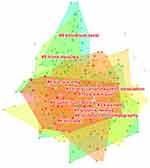Back to Journals » Journal of Pain Research » Volume 15
Research Hotspots of the Rehabilitation Medicine Use of sEMG in Recent 12 Years: A Bibliometric Analysis
Received 4 March 2022
Accepted for publication 3 May 2022
Published 10 May 2022 Volume 2022:15 Pages 1365—1377
DOI https://doi.org/10.2147/JPR.S364977
Checked for plagiarism Yes
Review by Single anonymous peer review
Peer reviewer comments 2
Editor who approved publication: Dr Alaa Abd-Elsayed
Liya Xu,1 Hongyi Gu,1 Yimin Zhang2
1Faculty of Sports and Human Sciences, Beijing Sports University, Beijing, People’s Republic of China; 2China Institute of sports and Health, Key Laboratory of sports and Physical Health Ministry of Education, Beijing Sports University, Beijing, People’s Republic of China
Correspondence: Yimin Zhang, China Institute of sports and health, Key Laboratory of sports and physical health Ministry of Education, Beijing Sports University, Beijing, 100084, People’s Republic of China, Tel +86 13641108252, Email [email protected]
Objective: Surface electromyography (sEMG) has been widely applied to rehabilitation medicine. However, the bibliometric analysis of the rehabilitation medicine use of sEMG is vastly unknown. Therefore, this research aimed to investigate the current trends of the rehabilitation medicine use of sEMG in the recent 12 years by using CiteSpace (5.8).
Methods: Literature relating to rehabilitation medicine use of sEMG from 2010 to 2021 was retrieved from the Web of Science. CiteSpace analyzed country, institution, cited journals, authors, cited references and keywords. An analysis of counts and centrality was used to reveal publication outputs, countries, institutions, core journals, active authors, foundation references, hot topics and frontiers.
Results: A total of 1949 publications were retrieved from 2010 to 2021. The total number of publications continually increased over the past 12 years, and the most active countries, institutions, journals and authors in rehabilitation medicine use of sEMG were identified. The most productive country and institution in this field were America (484) and the University of Sao Paulo (36). Andersen LL (28) was the most prolific author, and Dario Farina ranked first among the cited authors. Besides, there were three main frontiers in keywords for sEMG research, including “activation”, “exercise”, and “strength”.
Conclusion: The findings from this bibliometric study provide the current status and trends in clinical research of rehabilitation medicine use of sEMG over the past ten years, which may help researchers identify hot topics and explore new directions for future research in this field.
Keywords: surface electromyography, rehabilitation medicine, bibliometric analysis, CiteSpace
Introduction
Surface electromyography (sEMG) referred to the collective electric signal from muscles controlled by the nervous system and produced during muscle contraction and is guided and recorded from the surface of the human power through the electrode.1,2 Placing the surface electrode on the skin and conducting, amplifying, displaying and recording these electrical signals can reflect the synchronization of motor unit activities, muscle fibre recruitment, muscle fatigue, muscle activation sequence and activation time to a certain extent.3 The standard analysis methods of sEMG could be divided into the time-domain analysis (linear analysis) and frequency domain analysis (nonlinear analysis). The common analysis indexes in domain analysis were average electromyography (AEMG), root mean square (RMS), integrated electromyography (iEMG) and synergistic contractility; the frequency domain indicators included median frequency and average power frequency.4 Mulroy applied sEMG to analyze the electromyography activities of the supraspinatus muscle and posterior deltoid muscle in patients with post-stroke hemiplegic shoulder pain and compared the degree of shoulder subluxation and pain local muscle activation and upper limb function before and after treatment.5 The results showed that task-oriented EMG biofeedback treatment could improve the degree of shoulder subluxation, pain, muscle activation and upper limb role in patients with post-stroke hemiplegic shoulder pain. Tabard used surface electromyography biofeedback (sEMG-B) to diagnose and treat the elderly after stroke and determined the effectiveness of sEMG-B in the muscles responsible for hand extension and foot dorsum extension in elderly subjects after stroke.6 sEMG signals are considered most useful as electrophysiological signals in medical and engineering fields.5,7 As a safe and noninvasive tool for neuromuscular function evaluation, sEMG is widely used in rehabilitation medicine.8–10
Bibliometrics is a cross-science that uses mathematical and statistical methods to analyze all knowledge carriers quantitatively.11 It is a statistical analysis and quantitative tool for research publications. Evaluative bibliometrics is a field of quantitative science that has emerged as a powerful tool to evaluate research performance, which can identify influential articles that have shaped the medical practice and fostered new research ideas.12–14 In recent years, there has been growing recognition of the significance of the rehabilitation medicine use of sEMG. At present, the number of papers published in related fields is increasing, but no scholars have carried out a comprehensive literature visual analysis based on a knowledge map in this field. Therefore, it is essential to understand the current status of the rehabilitation medicine use of sEMG as a whole. This study aims to evaluate the research trends of the rehabilitation medicine use of sEMG and conduct a macroscopic overview of a significant amount of academic literature in the past 12 years through bibliometric analysis.
CiteSpace visual analysis software is a kind of scientific literature visual analysis software based on Java language, created by Dr Chaomei Chen (School of Information Science and Technology, Drexel University, Philadelphia, PA, USA).15,16 In this study, CiteSpace was used to make a bibliometric analysis to explore the current status and research trends on the global rehabilitation medicine use of sEMG within the past 12 years (from 2010 to 2021). All eligible literature was extracted from the Web of Science database to provide some reference for the research in this field and the development of related disciplines.
Methods
Data Source and Search Strategy
Two independent searchers selected the retrieval data used for measurement and statistical analysis from the Web of Science Core Collection (WoSCC). It provides citation search, allows access to multiple databases referring to interdisciplinary research, and allows in-depth exploration of professional subareas. The data retrieval time range was from January 1, 2010, to December 31, 2021; the data type of WoSCC was “article” and “review”, the language was “English”, and data such as conference abstracts, proofreading notices, news, conference papers and withdrawal notices were excluded. Full-text records and cited references were selected in plain text format and downloaded for further analysis. The specific search strategies are shown in Table 1.
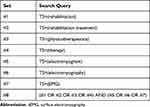 |
Table 1 The Topic Search Query |
Analysis Tool and Data Analysis
This study utilized CiteSpace V.5.8.R3 to analyze existing studies related to the rehabilitation medicine use of sEMG and aims to evaluate the research trends in this field.17 CiteSpace was invented by Dr Chaomei Chen (School of Information Science and Technology, Drexel University, Philadelphia, PA, USA) and his team in 2004 and used to determine the information related according to countries, institutions, active authors, foundation references and so on in the data. The parameters of CiteSpace were set as below: selected the period was from January 2010 to December 2021, years per slice (1); the subject word source and critical path were the system default values; the threshold item was selected as “top n” and liked it to 50. Visualization knowledge figures were mainly composed of nodes and links. The node type was determined according to the kind of analysis performed. The node types, countries, institutions, authors and keywords were analyzed to form visualization knowledge figures. The observable indicators in the Visualization knowledge figures were: the number of nodes, node size and colours of nodes, etc. The node’s size, which commonly suggests the frequency of appearance or citation, and links between nodes represent relationships of collaboration. The purple circles represent centrality. High centrality is usually regarded as a turning point or critical point in the field.18,19
Results and Discussion
Annual Publications Trends
Through the method of searching topic words, it was found that a total of 1949 articles in related fields were included on the Web of Science. The number of rehabilitation medicine use of sEMG research papers was generally increasing year by year, but the growth rate was slow. The number of articles published each year is shown in Figure 1. The period from 2010 to 2014 was a gradual development period, and the publication outputs were 133 references in 2010, rising to 187 contacts in 2014. However, from 2014 to 2015, publications decreased from 187 references to 146 references. From 2015 to 2019, the number of articles published increased significantly, and the highest number of articles published in 2019 was 193 references, reaching the peak in the recent 12 years. However, the number of articles published felled to 153 in 2018. Furthermore, the number of publications decreased slightly, from 193 references in 2019 to 186 references in 2021, but it remained at a high level. These results indicate that sEMG, detection and treatment tool for rehabilitation medicine, is receiving increased attention, and more surface electromyography research is being performed.20–25
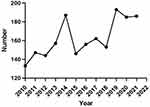 |
Figure 1 The annual number of publications on the rehabilitation medicine use of sEMG between 2010 to 2021 on the Web of Science. Abbreviation: sEMG, surface electromyography. |
Analysis of Country and Institution
The country distribution map was generated through CiteSpace, and 79 nodes and 243 links form the combined network (Figure 2). The 1949 references were published by researchers in 79 countries. The top five countries in the publication quantity were the USA, the People’s Republic of China, Canada, Brazil and Italy (Table 2). A total of 484 articles have been published in the United States, which may be related to the origin of EMG in the West. China was ranked in the second position in the number of published literature (200), indicating that the rehabilitation medical application of sEMG has been widely used in China. The top five countries in terms of centrality (purple round) were the USA (0.41), Germany (0.23), Australia (0.19), Italy (0.12) and England (0.10), which indicated that these five countries had established good research cooperation relations with other countries (Table 2). Interestingly, the USA was not only the most prolific country but also the highest centrality country, suggesting that the USA is the most important country for researching rehabilitation medicine of application of sEMG. Analysis shows that China has issued many publications in the past 12 years, but the centrality was not dominant (0.05).26–28
 |
Table 2 Top 10 Prolific Countries and Institutions Were Researching the Rehabilitation Medicine Use of sEMG Between 2010 to 2021 on the Web of Science |
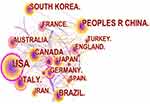 |
Figure 2 Map of countries researching the rehabilitation medicine use of sEMG from 2010 to 2021 on the Web of Science. Abbreviation: sEMG, surface electromyography. |
The institution distribution map was generated through CiteSpace, and 381 nodes and 284 links form the combined network (Figure 3). The 1949 references were distributed among 381 research institutions. The top five institutions in the publication quantity were the University of Sao Paulo, Yonsei University of Korea, University of Montreal, University of Aalborg and Shanghai Jiaotong University (Table 2). The University of Sao Paulo in Brazil has published the most significant number of studies (36), followed by the Yonsei University of Korea (28) and the University of Montreal in Canada (20). Therefore, based on the publications, we found that the institutions from Brazil, Korea, Canada and China paid more concerned with the research of the rehabilitation medicine use of sEMG currently.29,30
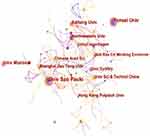 |
Figure 3 Map of institutions researching the rehabilitation medicine use of sEMG from 2010 to 2021 on the Web of Science. Abbreviation: sEMG, surface electromyography. |
Analysis of Author and Cited Authors
The authors of the 1949 publications were analyzed and resulted in 553 nodes and 566 links (Figure 4), expressing that the 1949 articles were published by 553 authors. Eight authors have published more than 15 articles. The author map was designed to show the most productive authors and reveal the close cooperation between authors, which could provide messages about influential research teams and latent cooperators and help researchers build partnerships. The top 5 authors were Andersen LL, Zhang X, Zhou P, Chen X and Hu XL (Table 3).29,31–39 They are active and professional authors in this field. The most prolific author was Andersen LL, from the Mayo Clinic in the United States, with 28 articles. Andersen LL chose high-intensity resistance training for the prevention and rehabilitation of musculoskeletal injuries and diseases and measured the degree of muscle activation with electromyography. His results show that a relatively high level of muscle activation was obtained in resistance training using dumbbells and flexible catheters, and sEMG can be a valuable tool to detect muscle activation. There were some collaborations between Andersen LL, Zhang X, Zhou P, and Hermens HJ. However, the centrality for such partnerships was low, and Professor Farina D had the highest document centrality (0.17). This indicates a lack of close cooperation among authors in this field. In the future, authors can strengthen collaboration and create more high-quality research.
 |
Table 3 Top 10 Prolific Authors and Cited Authors Related to the Rehabilitation Medicine Use of sEMG Between 2010 to 2021 on the Web of Science |
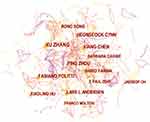 |
Figure 4 Map of author related to the rehabilitation medicine use of sEMG from 2010 to 2021 on the Web of Science. Abbreviation: sEMG, surface electromyography. |
The map of cited authors was composed of 642 nodes and 3661 links (Figure 5). The top five cited authors were Hermens HJ, De Luca CJ, Farina D, Hodges PW and Winter DA. Hermens HJ had the highest citation counts (405), followed by De Luca CJ (207), Farina D (186), Hodges PW (176) and Winter DA (152) (Table 3). Hermens HJ ranked first in the cited author frequency, and he is a professor at the University of Virginia. There is some cooperation among the author teams, which is more evident among the high-yield authors, but there is a lack of highly focused authors. Chinese scholars account for 50% of the highly influential authors.
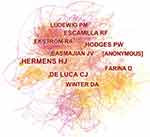 |
Figure 5 Map of cited author related to the rehabilitation medicine use of sEMG from 2010 to 2021 on the Web of Science. Abbreviation: sEMG, surface electromyography. |
Analysis of Cited References
The map of cited references with 641 nodes and 1214 links were obtained (Figure 6). The top 10 frequency of cited references were shown in Table 4. By analyzing the literature with high co-citation frequency, we can obtain the knowledge base of this field. The top 5 articles were published in Physical Therapy, Journal of Orthopaedic & Sports Physical Therapy, Lasers in Medical Science, BMC Musculoskeletal Disorders and Journal of Orthopaedic & Sports Physical Therapy, respectively, implying that the importance of these articles in this field, which has also had a far-reaching impact in this field. The cited situation was one of the important indicators to reflect the research hotspots. Through reading and analyzing the documents with high cited frequency and centrality, we could understand some research results with high attention, so as to reveal the areas of concern in the research. It was found that resistance training, biomechanics, low-intensity laser EMG therapy, shoulder joint, injury risk, trunk muscle and lower limb muscle strength had received extensive attention from researchers by reading and analyzing the top 10 highly cited literatures.40 Among the top 10 highly cited literatures, there were 4 literatures on Low-level laser therapy (LLLT). Some scholars believed that using LLLT before high-intensity running can improve exercise performance and reduce exercise-induced oxidative stress and muscle injury, which indicated that the regulation of LLLT on oxygenation reduction system might be related to the delay of skeletal muscle fatigue observed after using LLLT.41
 |
Table 4 Top 10 Frequency of Cited References Related to the Rehabilitation Medicine Use of sEMG Between 2010 to 2021 on the Web of Science |
 |
Figure 6 Map of cited references related to the rehabilitation medicine use of sEMG from 2010 to 2021 on the Web of Science. Abbreviation: sEMG, surface electromyography. |
Analysis of Keyword
Keyword Cooccurrence
With the passage of time, the knowledge map of keyword co-occurrence could reflect the research hotspots, and burst keywords play a key role in summarizing the frontier topics of research. The map of keywords co-collocation was produced and consisted of 455 nodes and 668 links (Figure 7). An analysis in the light of co-occurrence frequency and centrality (Table 5 and Figure 7) disclosed that the hot keywords were activation, abdominal muscle, exercise, disability, controlled trial, low back pain and feedback. Andersen found that a higher level of muscle activation was obtained by comparing the muscle activation and perceived load of dumbbell and elastic catheter in upper limb resistance training. Chester, DiStefano, Escamilla and Ekstrom explored the role of sEMG in assessing the risk of injury by stimulating different parts of sEMG.
 |
Table 5 Top 10 Frequency and Centrality of Keywords Related to the Rehabilitation Medicine Use of sEMG Between 2010 to 2021 on the Web of Science |
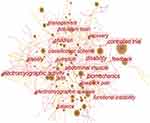 |
Figure 7 Map of keywords occurrence related to the rehabilitation medicine use of sEMG from 2010 to 2021 on the Web of Science. Abbreviation: sEMG, surface electromyography. |
Burst Keywords
Burst words represent frequently cited keywords in a certain period of time, indicating hot spots and trends. Figure 8 shows the top 8 keywords with the most powerful citation burst from 2010 to 2021. The mutation cycle of six burst words is concentrated in 2010–2015. The most recent burst keywords were lumbar spine, risk factor and design. The emg analysis was the most intense mutation (6.32); the second was the lumbar spine (5.68); in the third place was the risk factor (5.16). The research on the burst word “design” continued until now, and it was likely to maintain the research heat all the time.
Keyword Cluster
The clusters were named by extracting keywords from the titles of references as tags. The LLR (log-likelihood ratio) algorithm was used for the purpose of the extraction method. Figure 9 demonstrates the clustering visualization of the keyword co-reference network, which is divided into ten co-reference clusters. The top five keyword clusters were 0# pattern recognition, 1# low back pain, 2# transcranial magnetic stimulation, 3# kinematic, 4# shoulder and 5# trunk muscles. The keyword cluster of #0, #1, #2, #3 were closely intertwined, which could be summarized as the scope of application of sEMG; the cluster of #4, #5, #6, #7 were staggered, which could be translated as the applicable parts of sEMG. The keyword co-occurrence and cluster analysis could obtain biomechanical angles, different muscle parts, different populations and randomized controlled trials, which were the research hotspots in this field.
There were some limitations in our study. Firstly, we only searched the literature in the core database of the web of science, which might ignore the high-quality literature of other databases in this field. There were some limitations in literature retrieval, which was not conducive to the summary of research hotspots. In addition, although the research subject words were limited in the search, we could not ensure that every document was wholly related to the subject. However, we believe that our research can still be used to describe the overall situation and trends in the rehabilitation medicine use of the sEMG field.
Conclusion
As a safe and noninvasive detection technology for quantifying the bioelectrical activity of the neuromuscular system, sEMG was helpful to deeply understanding the behaviour of the neuromuscular system and can better evaluate the muscle function, muscle activation and coordination of patients. At the same time, it could also purposefully guide the rehabilitation treatment of patients and evaluate the rehabilitation effect. It could be found that the current research paid more attention to the influence of sEMG on its movement mechanism, focusing on its internal theoretical mechanism. At the same time, the study also paid special attention to children and people with disabilities.42 Many developed countries and famous institutions had close cooperative relations, which was conducive to the development of the rehabilitation medicine use of sEMG.42,43
In this study, many countries had published papers on related topics, among which Chinese scholars had issued a large number of documents, but the centrality was low. The main research hotspots of Chinese scholars primarily focused on stroke, pelvic floor function, walking ability and shoulder joint. The characteristic research hotspots were acupuncture and the rehabilitation of traditional Chinese medicine (TCM). Chinese scholars paid more attention to the research of clinical treatment and paid less attention to the research of injury mechanisms. Therefore, we need to continue to follow the international research direction, increase the research on the tool and continue to increase the research on TCM rehabilitation in the future so as to promote the formation of unique research results. The hot topics and research frontiers discussed in this study revealed the development trend of the rehabilitation medicine use of sEMG, which might help researchers redefine new directions and priorities.
In conclusion, this study provides the rehabilitation medicine use of sEMG with in-depth understanding and valuable information for rehabilitation researchers so as to help researchers explore new directions and new topics for future research in this field.
Acknowledgments
The authors would like to express their appreciation to Professor CM Chen, who invented CiteSpace, which is free to use. This study was supported by the National key R & D plan (2020YFC2006701).
Author Contributions
All authors made substantial contributions to conception and design, acquisition of data, or analysis and interpretation of data; took part in drafting the article or revising it critically for important intellectual content; agreed to submit to the current journal; gave final approval of the version to be published; and agree to be accountable for all aspects of the work. Liya XU is the co-first author.
Disclosure
We declare that we do not have any commercial or associative interest that represents a conflict of interest in connection with the work submitted.
References
1. Wang YJ, Li JJ, Zhou HJ, et al. Surface electromyography as a measure of trunk muscle activity in patients with spinal cord injury: a meta-analytic review. J Spinal Cord Med. 2016; 39(1): 15–23. doi:10.1179/2045772315Y.0000000059
2. Wang F, Yiu EM. Is surface electromyography (sEMG) a useful tool in identifying muscle tension dysphonia? An integrative review of the current evidence. J Voice. 2021;10(1): 21–30
3. Neblett R. Surface electromyographic (SEMG) biofeedback for chronic low back pain. Healthcare. 2016;4(2): 111–130 doi:10.3390/healthcare4020027
4. Archer SK, Smith CH, Newham DJ Surface electromyographic biofeedback and the effortful swallow exercise for stroke-related dysphagia and in healthy ageing. Dysphagia. 2021;36(2): 281–292. doi:10.1007/s00455-020-10129-8
5. Mulroy SJ, Hatchett P, Eberly VJ, et al. Shoulder strength and physical activity predictors of shoulder pain in people with paraplegia from spinal injury: prospective cohort study. Phys Ther. 2015;95(7): 1027–1038. doi:10.2522/ptj.20130606
6. Gámez AB, Hernandez Morante JJ, Martínez Gil JL, et al. The effect of surface electromyography biofeedback on the activity of extensor and dorsiflexor muscles in elderly adults: a randomized trial. Sci Rep. 2019;9(1): 131–153. doi:10.1038/s41598-019-49720-x
7. Goffredo M, Infarinato F, Pournajaf S, et al. Barriers to sEMG assessment during overground robot-assisted gait training in subacute stroke patients. Front Neurol. 2020;11:564–567. doi:10.3389/fneur.2020.564067
8. Medved V, Medved S, Kovač I. Critical appraisal of surface electromyography (sEMG) as a taught subject and clinical tool in medicine and kinesiology. Front Neurol, 2020, 11: 56–63. doi:10.3389/fneur.2020.560363
9. Moniri A, Terracina D, Rodriguez-Manzano J, et al. Real-time forecasting of sEMG features for trunk muscle fatigue using machine learning. IEEE Trans Biomed Eng, 2021, 68(2): 718–727. doi:10.1109/TBME.2020.3012783
10. Zhong T, Li D, Wang J, et al. Fusion learning for sEMG recognition of multiple upper-limb rehabilitation movements. Sensors, 2021, 21(16): 18–26. doi:10.3390/s21165385
11. Ozsoy Z, Demir E Correction to: which bariatric procedure is the most popular in the world? A bibliometric comparison. Obes Surg.2018;28(8):23–53.
12. Zhang L, Yuan H, Zhang L, Li J, Li H. Effect of acupuncture therapies combined with usual medical care on knee osteoarthritis. J Tradit Chin Med. 2019;39(1):103–110.
13. Wang TQ, Li YT, Wang LQ, et al. Electroacupuncture versus manual acupuncture for knee osteoarthritis: a randomized controlled pilot trial. Acupunct Med. 2020;2020:569–575
14. Belter CW Bibliometric indicators: opportunities and limits. J Med Libr Assoc. 2015;103(4):219–221. doi:10.3163/1536-5050.103.4.014
15. Chen N, Wang J, Mucelli A, Zhang X, Wang C Electro-acupuncture is beneficial for knee osteoarthritis: the evidence from meta-analysis of randomized controlled trials. Am J Chin Med. 2017;45(5):965–985. doi:10.1142/S0192415X17500513
16. Chen C, SanJuan FI, Hou J The structure and dynamics of cocitation clusters: a multiple-perspective cocitation analysis. J Am Soc Info Ence Technol. 2010;61:7–14.
17. Synnestvedt MB, Chen C, Holmes JH, CiteSpace II: visualization and knowledge discovery in bibliographic databases. AMIA Annu Symp Proc. 2005;2005:724–728
18. Zhang Y, Li C, Ji X, Yun C, Wang M, Luo X. The knowledge domain and emerging trends in phytoremediation: a scientometric analysis with CiteSpace. Environ Sci Pollut Res Int. 2020;27(13):15515–15536. doi:10.1007/s11356-020-07646-2
19. Liang C, Luo A, Zhong Z Knowledge mapping of medication literacy study: a visualized analysis using CiteSpace. Sage Open Med. 2018;6:210–219. doi:10.1177/2050312118800199
20. Ai-quraishi MS, Ishak AJ, Ahmad SA, et al. Impact of feature extraction techniques on classification accuracy for EMG based ankle joint movements.
21. Crary MA, Baldwin BO Surface electromyographic characteristics of swallowing in dysphagia secondary to brainstem stroke. Dysphagia. 1997;12(4):180–187. doi:10.1007/PL00009534
22. Hamdy S, Mikulis DJ, Crawley A, et al. Cortical activation during human volitional swallowing: an event-related fMRI study. Am J Physiol.1999;277(1):219–225.
23. Spronk PE, Spronk L, Lut J, et al. Prevalence and characterization of dysphagia in hospitalized patients. Neurogastroenterol Motil. 2020;32(3):137–143. doi:10.1111/nmo.13763
24. Vaiman M, Shoval G, Gavriel H Malingering dysphagia and odynophagia electromyographic assessment. Am J Otolaryngol. 2009;30(5):318–323. doi:10.1016/j.amjoto.2008.07.002
25. El GA, Berretin-Felix G, Rossoni DF, et al. Effectiveness of therapy on post- extubation dysphagia: clinical and electromyographic findings. Clin Med Insights Ear Nose Throat. 2019;12:843–852.
26. Wang YC, Chou W, Lin BS, et al. The use of surface electromyography in dysphagia evaluation. Technol Health Care. 2017; 25(5):1025–1028. doi:10.3233/THC-170892
27. Zhu M, Yu B, Yang W, et al. Evaluation of normal swallowing functions by using dynamic high-density surface electromyography maps. Biomed Eng Online.2017;16(1):133–150. doi:10.1186/s12938-017-0424-x
28. Tang X, Liu Y, Lv C, et al. Hand motion classification using a multi-channel surface electromyography sensor. Sensors. 2012;12(2): 1130–1147. doi:10.3390/s120201130
29. Farina D, Jiang N, Rehbaum H, et al. The extraction of neural information from the surface EMG for the control of upper-limb prostheses: emerging avenues and challenges. IEEE Trans Neural Syst Rehabil Eng. 2014;22(4): 797–809.
30. Phinyomark A, Nuidod A, Phukpattaranont P, et al. Feature extraction and reduction of wavelet transform coefficients for EMG pattern classification. Elektron ir Elektron. 2012;122(6): 27–32. doi:10.5755/j01.eee.122.6.1816
31. Andersen LL, Andersen CH, Mortensen OS, et al. Muscle activation and perceived loading during rehabilitation exercises: comparison of dumbbells and elastic resistance. Phys Ther. 2010;90(4): 538–549. doi:10.2522/ptj.20090167
32. Reinold MM, Escamilla RF, Wilk KE Current concepts in the scientific and clinical rationale behind exercises for glenohumeral and scapulothoracic musculature. J Orthop Sports Phys Ther. 2009;39(2): 105–117. doi:10.2519/jospt.2009.2835
33. Chester R, Smith TO, Hooper L, et al. The impact of subacromial impingement syndrome on muscle activity patterns of the shoulder complex: a systematic review of electromyographic studies. BMC Musculoskelet Disord. 2010;11:45–50. doi:10.1186/1471-2474-11-45
34. Distefano LJ, Blackburn JT, Marshall SW, et al. Gluteal muscle activation during common therapeutic exercises. J Orthop Sports Phys Ther. 2009;39(7): 532–540. doi:10.2519/jospt.2009.2796
35. Escamilla RF, Yamashiro K, Paulos L, et al. Shoulder muscle activity and function in common shoulder rehabilitation exercises. Sports Med. 2009;39(8): 663–685. doi:10.2165/00007256-200939080-00004
36. Kraemer WJ, Adams K, Cafarelli E, etal. American college of sports medicine position stand. progression models in resistance training for healthy adults. Med Sci Sports Exerc. 2009;41(3): 687–708. doi:10.1249/MSS.0b013e3181915670
37. Higashi RH, Toma RL, TucciH T, et al. Effects of low-level laser therapy on biceps braquialis muscle fatigue in young women. Photomed Laser Surg. 2013; 31(12): 586–594. doi:10.1089/pho.2012.3388
38. Ekstrom RA, Donatelli RA, Carp KC Electromyographic analysis of core trunk, hip, and thigh muscles during 9 rehabilitation exercises. J Orthop Sports Phys Ther. 2007;37(12): 754–762. doi:10.2519/jospt.2007.2471
39. De Marchi T, Leal Junior EC, Bortoli C, et al. Low-level laser therapy (LLLT) in human progressive-intensity running: effects on exercise performance, skeletal muscle status, and oxidative stress. Lasers Med Sci, 2012, 27(1): 231–236. doi:10.1007/s10103-011-0955-5
40. Yang P, Hwa Yang Y, Zhou B, et al. A review of ensemble methods in bioinformatics. Curr Bioinform. 2010;5(4): 296–308. doi:10.2174/157489310794072508
41. De Luca CJ, Gilmore LD, Kuznetsov M, et al. Filtering the surface EMG signal: movement artifact and baseline noise contamination. J Biomech. 2010;43(8): 1573–1579. doi:10.1016/j.jbiomech.2010.01.027
42. Srisuwan N, Phukpattaranont P, Limsakul C Feature selection for Thai tone classification based on surface EMG. Procedia Eng. 2012;32:253–259.
43. Shi WT, Lyu ZJ, Tang ST, et al. A bionic hand controlled by hand gesture recognition based on surface EMG signals: a preliminary study. Biocybern Biomed Eng. 2018;38(1): 126–135. doi:10.1016/j.bbe.2017.11.001
 © 2022 The Author(s). This work is published and licensed by Dove Medical Press Limited. The full terms of this license are available at https://www.dovepress.com/terms.php and incorporate the Creative Commons Attribution - Non Commercial (unported, v3.0) License.
By accessing the work you hereby accept the Terms. Non-commercial uses of the work are permitted without any further permission from Dove Medical Press Limited, provided the work is properly attributed. For permission for commercial use of this work, please see paragraphs 4.2 and 5 of our Terms.
© 2022 The Author(s). This work is published and licensed by Dove Medical Press Limited. The full terms of this license are available at https://www.dovepress.com/terms.php and incorporate the Creative Commons Attribution - Non Commercial (unported, v3.0) License.
By accessing the work you hereby accept the Terms. Non-commercial uses of the work are permitted without any further permission from Dove Medical Press Limited, provided the work is properly attributed. For permission for commercial use of this work, please see paragraphs 4.2 and 5 of our Terms.


